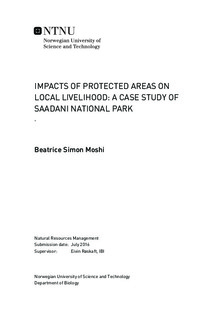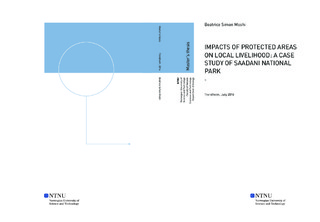| dc.description.abstract | ABSTRACT
The study examines the impacts of protected area (PA) (Saadani National Park, SANAPA) has on livelihood of local people. Local people from 200 households were interviewed. Data were collected from June to August 2015 through a simple, randomly-sampling, questionnaire survey, interview with key informants; focus group discussions; and reviews of published and unpublished journals and articles. Local people were found to have little access to natural, physical and financial resources because of the laws and regulations surrounding the establishment of the PA, and hence, PA undermined their livelihoods. Local communities engaged in different activities, but agriculture and fishing were the main source of income in the two groups of villages. Positive park effects include: support for social development projects, park-related employment and ecotourism benefits.
The results revealed that the PA is also associated with the costs, such as crops damage, human injuries, livestock depredation, restrictions in accessing resources and boundaries conflict. Crops raiding was the major problem in the villages far from the park, where as livestock depredation was highest in the villages close to the park. The majority of respondents had negative attitudes towards the park. Different factors, such as the benefits and costs of the park and the restriction on the access to different assets including land as well as the involvement and participation of local people in conservation, were the main reasons for these negative attitudes. Little awareness of the benefits provided by SANAPA was associated with poor involvement and participation by local communities in the management of resources, which resulted in bad relation between locals and the park. Households that were involved and benefited from the park supported its existence compared to those that were not involved and received no benefits from the conservation activities. Education was significant in influencing an awareness of the benefits in locals. Due to costs from the park, local people who practiced fishing and farming were negatively affected and want the park to be removed compared to local people with alternative livelihood activities. Access to different resources especially land were seen to be an important factor in diversification of different activities. Therefore this study recommends that, conservation-related benefits should offset the costs and different communities project should improve the living standard of local through poverty alleviation as well as target the immediate livelihood needs. In addition, the involvement of local people and alternative livelihood should be considered during the planning and management of PAs. PAs should encourage education as a way of creating awareness on conservation-related benefits, which will help to change local people attitudes and hence, achieve the long-term conservation goals.
Key words: Impacts of protected areas, sustainable livelihood, benefit-sharing, local community attitudes.
| |

